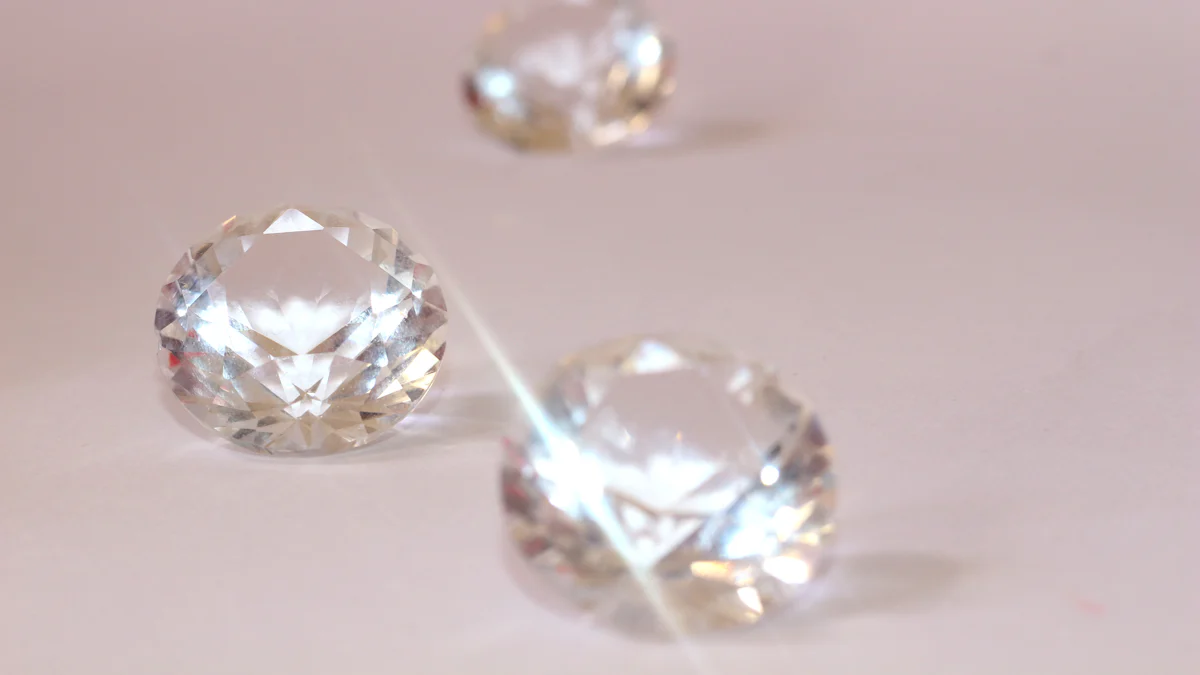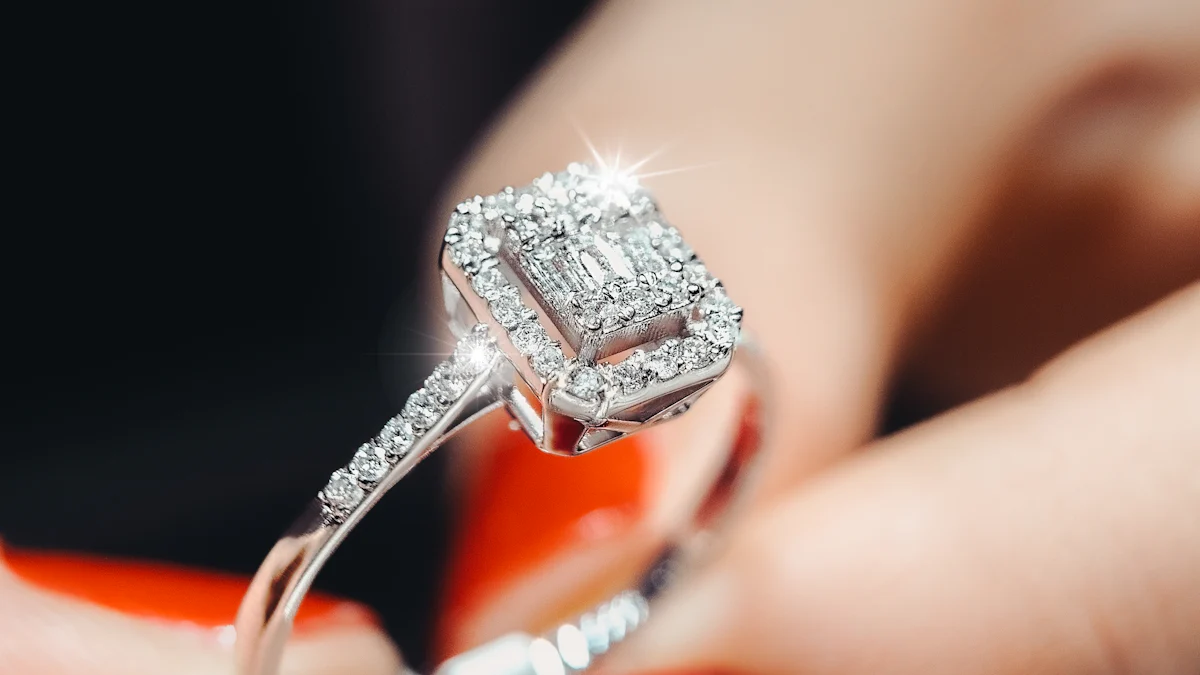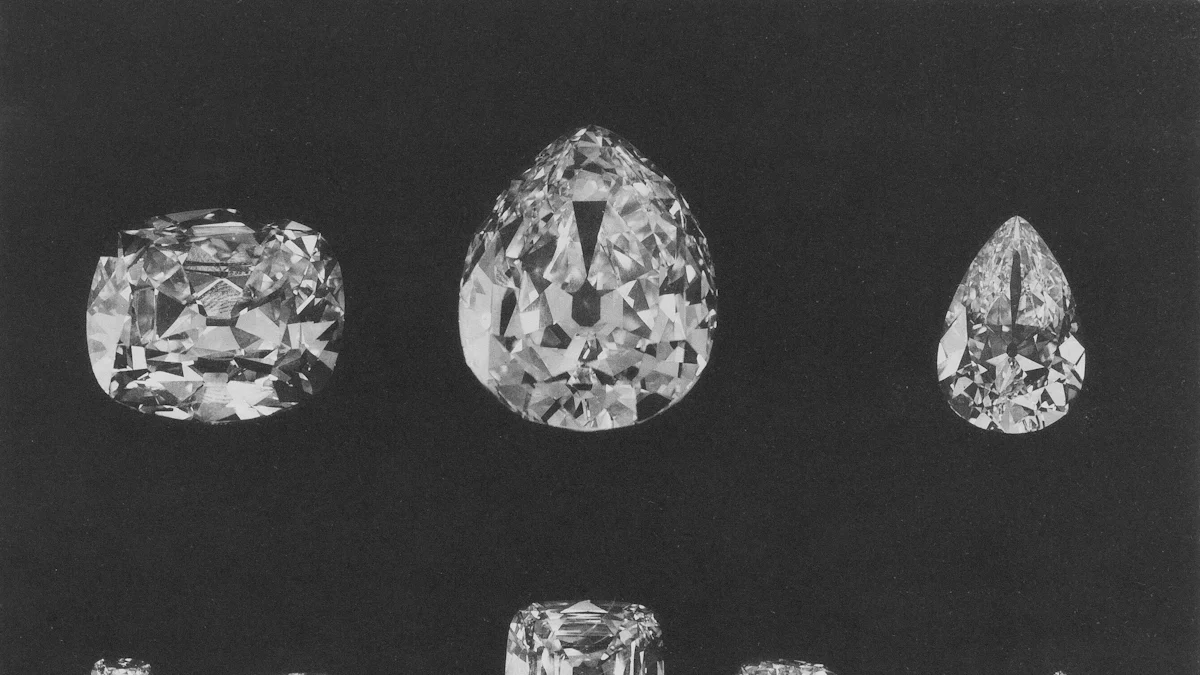Understanding the Difference Between VS and VVS Diamonds

When choosing a diamond, understanding clarity is essential. The difference between VS and VVS diamonds lies in their inclusions, which is crucial for discerning their quality. VS diamonds, or "Very Slightly Included," have small inclusions that are visible under 10x magnification. In contrast, VVS diamonds, meaning "Very, Very Slightly Included," feature even fewer and smaller inclusions, making them nearly flawless. These inclusions are so minimal that even skilled graders struggle to detect them. VVS diamonds represent less than 1% of all natural diamonds, offering exceptional brilliance and rarity. Your choice depends on your priorities, whether it's clarity, budget, or overall appearance.
What Is Diamond Clarity and Why Does It Matter?
Diamond clarity plays a crucial role in determining the overall quality and value of a diamond. It refers to the presence or absence of internal characteristics, known as inclusions, and external imperfections, called blemishes. These factors directly impact how light interacts with the diamond, influencing its brilliance and sparkle. Understanding clarity helps you make informed decisions when selecting a diamond that aligns with your preferences and budget.
Overview of the Diamond Clarity Grading Scale
The clarity grading scale, established by the Gemological Institute of America (GIA), categorizes diamonds based on the size, number, and visibility of inclusions and blemishes under 10x magnification. This scale includes six primary grades:
- Flawless (FL): No inclusions or blemishes visible under 10x magnification.
- Internally Flawless (IF): No inclusions, but minor blemishes may be present.
- Very, Very Slightly Included (VVS1 and VVS2): Minute inclusions that are extremely difficult to detect, even for skilled graders.
- Very Slightly Included (VS1 and VS2): Small inclusions that are slightly easier to see under magnification.
- Slightly Included (SI1 and SI2): Noticeable inclusions visible under magnification and sometimes to the naked eye.
- Included (I1, I2, and I3): Obvious inclusions that may affect the diamond's durability and brilliance.
Each grade reflects the rarity and visual appeal of the diamond. For instance, VVS diamonds, divided into VVS1 and VVS2, have inclusions so minute that even experts find them challenging to spot. These diamonds are highly sought after for their exceptional clarity and rarity.
How Inclusions and Blemishes Affect a Diamond
Inclusions and blemishes significantly influence a diamond's appearance and value. Inclusions, such as tiny crystals, feathers, or clouds, form naturally during the diamond's creation process. Blemishes, like scratches or nicks, occur on the diamond's surface. While these imperfections are often microscopic, they can affect how light passes through the diamond, reducing its brilliance and sparkle.
For example, VVS diamonds contain inclusions that are nearly invisible under magnification, ensuring superior clarity and brilliance. In contrast, VS diamonds may have slightly larger or more noticeable inclusions, though they remain an excellent choice for those seeking high-quality diamonds at a more accessible price point. By understanding how inclusions and blemishes impact a diamond, you can prioritize the features that matter most to you.
Understanding the Difference Between VS and VVS Diamonds
When comparing the difference between VS and VVS diamonds, it’s essential to understand their unique characteristics. Both clarity grades represent high-quality options, but their inclusions and rarity set them apart. Let’s explore what makes each grade distinct.
What Are VS Diamonds?
VS diamonds, short for "Very Slightly Included," contain small inclusions that are typically invisible to the naked eye. These inclusions may include tiny crystals, feathers, or clouds, which are only noticeable under 10x magnification. Despite these minor imperfections, VS diamonds maintain excellent brilliance and sparkle, making them a popular choice for buyers seeking a balance between quality and affordability.
The VS clarity grade is further divided into two subcategories:
- VS1 Diamonds: These diamonds have fewer and smaller inclusions compared to VS2 diamonds. Their inclusions are often located in less noticeable areas, ensuring a clean appearance.
- VS2 Diamonds: These diamonds may have slightly more visible inclusions under magnification, but they still appear eye-clean in most cases.
VS diamonds offer exceptional value for their price. If you prioritize a diamond that looks flawless to the naked eye without exceeding your budget, VS diamonds are an excellent option.
What Are VVS Diamonds?
VVS diamonds, or "Very, Very Slightly Included" diamonds, represent a higher clarity grade than VS diamonds. These diamonds feature inclusions so minute that even skilled gemologists struggle to detect them under magnification. To the naked eye, VVS diamonds appear virtually flawless, offering unmatched brilliance and beauty.
The VVS clarity grade is also divided into two subcategories:
- VVS1 Diamonds: These diamonds have inclusions that are nearly impossible to spot, even under 10x magnification. They are among the highest clarity grades available, making them incredibly rare and valuable.
- VVS2 Diamonds: These diamonds have slightly more noticeable inclusions than VVS1 diamonds, but they remain exceptionally clear and brilliant.
Gemologists from diamonds.pro highlight that VVS diamonds appear virtually flawless to the naked eye due to their minuscule inclusions that are nearly impossible to discern without magnification.
Gemologists from astteria.com add that the inclusions in VVS diamonds are so small that they rarely affect the diamond’s brilliance or overall appearance. To the naked eye, VVS diamonds appear flawless, and their high clarity contributes to their exceptional sparkle and beauty.
VVS diamonds are ideal for those who value rarity and perfection. Their superior clarity ensures that light interacts beautifully with the diamond, enhancing its sparkle and brilliance. While they come at a premium price, VVS diamonds are often considered investment-grade due to their scarcity and exceptional quality.
By understanding the difference between VS and VVS diamonds, you can make an informed decision based on your preferences and priorities. Whether you choose VS diamonds for their value or VVS diamonds for their unparalleled clarity, both options offer stunning beauty and brilliance.
Visual Differences Between VS and VVS Diamonds

When examining VS and VVS diamonds, understanding their visual differences can help you make an informed choice. These differences primarily stem from the size, number, and placement of inclusions, which directly affect the diamond's appearance and overall clarity.
Can You See the Inclusions?
The visibility of inclusions is one of the most noticeable visual differences between VS and VVS diamonds. In VS diamonds, inclusions are small but may become visible under 10x magnification. These inclusions, such as tiny crystals or feathers, are often strategically placed in less noticeable areas, ensuring the diamond appears clean to the naked eye. However, under close inspection, you might detect these imperfections, especially in VS2 diamonds.
In contrast, VVS diamonds feature inclusions so minute that even skilled gemologists struggle to locate them under magnification. These inclusions are nearly invisible, giving VVS diamonds a flawless appearance to the naked eye. This exceptional clarity enhances their visual appeal, making them a preferred choice for those seeking perfection.
Research from Beard Fine Jewelers highlights that inclusions significantly influence a diamond’s clarity grade and value. Smaller inclusions, like those in VVS diamonds, contribute to their superior clarity and rarity.
Impact on Brilliance and Sparkle
The brilliance and sparkle of a diamond depend on how light interacts with its facets. Inclusions play a critical role in this interaction. Larger or poorly placed inclusions in VS diamonds can disrupt the path of light, slightly reducing their brilliance. However, most VS diamonds still maintain excellent sparkle, as their inclusions are typically small and strategically positioned.
VVS diamonds, with their minimal inclusions, allow light to pass through almost unobstructed. This results in unmatched brilliance and sparkle, giving these diamonds a radiant and luminous appearance. Their superior clarity ensures that light reflects and refracts beautifully, enhancing their visual charm.
Insights from Inspereza reveal that inclusions disrupt light within a diamond, affecting its sparkle and brilliance. The smaller and fewer the inclusions, the better the diamond’s light performance.
When comparing VS and VVS diamonds, the visual differences become evident in their inclusions and how these affect their brilliance. While both options offer stunning beauty, your choice should align with your preferences for clarity and appearance.
Price Differences Between VS and VVS Diamonds

When selecting a diamond, understanding how clarity impacts price is essential. The differences in clarity between VS and VVS diamonds significantly influence their cost, making it crucial to evaluate your priorities and budget.
How Clarity Impacts Price
The clarity grade of a diamond plays a major role in determining its price. VVS diamonds, with their superior clarity and minimal inclusions, command higher prices compared to VS diamonds. Their rarity and near-flawless appearance make them highly desirable among buyers seeking exceptional quality. For instance, VVS1 diamonds, which have inclusions nearly impossible to detect even under magnification, are among the most expensive in the clarity grading scale.
VS diamonds, while still offering excellent quality, are more affordable due to their slightly lower clarity grade. These diamonds contain inclusions that are small and often invisible to the naked eye, but they are more common than those found in VVS diamonds. This makes VS diamonds a popular choice for buyers who want high-quality diamonds without exceeding their budget.
Fact: As clarity improves, the price increases. VVS diamonds are more expensive than VS diamonds and significantly pricier than SI diamonds.
The price difference between VS and VVS diamonds can range from 15% to 50%, depending on factors like carat weight, cut, and color. While both options provide stunning brilliance, the higher clarity of VVS diamonds justifies their premium cost for those prioritizing rarity and perfection.
Budget Considerations for Buyers
Your budget plays a critical role in deciding between VS and VVS diamonds. If you value clarity above all else and have the financial flexibility, VVS diamonds offer unmatched brilliance and rarity. Their minimal inclusions ensure superior light performance, making them ideal for those seeking investment-grade diamonds or a flawless appearance.
On the other hand, VS diamonds provide excellent value for their cost. These diamonds balance quality and affordability, making them a practical choice for buyers who want a diamond that looks eye-clean without paying a premium. A VS diamond with well-placed inclusions can still deliver remarkable sparkle and beauty, ensuring you get a high-quality diamond within your budget.
Tip: Consider your priorities when choosing between VS and VVS diamonds. If clarity and rarity matter most, VVS diamonds are worth the investment. If you prefer a balance of quality and cost, VS diamonds are an excellent option.
By understanding the price differences and evaluating your budget, you can make an informed decision that aligns with your preferences. Whether you choose the unparalleled clarity of VVS diamonds or the exceptional value of VS diamonds, both options offer stunning quality and brilliance.
Buying VVS Diamonds vs. VS Diamonds: Key Considerations
When deciding between vvs diamonds and vs diamonds, understanding key factors can help you make the right choice. From certifications to personal preferences, each aspect plays a role in ensuring you select the perfect diamond for your needs.
Certification and Grading Reports
Certifications and grading reports are essential when purchasing diamonds. These documents verify the authenticity and quality of the diamond, providing detailed information about its clarity, cut, color, and carat weight. Trusted organizations like the Gemological Institute of America (GIA) and the American Gem Society (AGS) issue these reports. They assess each diamond and assign a grade based on the GIA Diamond Clarity Scale.
A reliable grading report ensures that the vvs diamonds or vs diamonds you consider meet the advertised standards. For example, a report for vvs1 diamonds will confirm their superior clarity and minimal inclusions. Always request the original lab certificate when buying vvs diamonds or vs diamonds. Additional diagnostics, such as Ideal Scope or ASET images, can provide further insights into the diamond's light performance and brilliance.
Tip: Ensure the diamond comes with a certification from a top-tier lab like GIA or AGS. This guarantees the diamond's quality and helps you make an informed decision.
Personal Preferences and Priorities
Your personal preferences and priorities should guide your choice between vvs diamonds and vs diamonds. If you value rarity and perfection, vvs diamonds are ideal. Their exceptional clarity and nearly flawless appearance make them stand out. On the other hand, if you prioritize affordability without compromising on quality, vs diamonds offer excellent value. They maintain remarkable brilliance while being more budget-friendly.
Consider how visible inclusions affect your perception of a diamond's beauty. Vvs diamonds have inclusions so small that even experts struggle to detect them under magnification. In contrast, vs diamonds may have slightly larger inclusions, but they remain invisible to the naked eye in most cases. Your choice depends on whether you prioritize perfection or practicality.
Fact: Vvs diamonds are rarer and more expensive due to their superior clarity. However, vs diamonds provide a balance of quality and cost, making them a popular choice for many buyers.
Practical Tips for Buyers
When deciding what to look for when buying vvs diamonds, follow these practical tips to ensure a confident purchase:
- Set a Budget: Determine how much you’re willing to spend. Vvs diamonds typically cost more than vs diamonds, so knowing your budget helps narrow your options.
- Examine the Diamond: Request high-quality images or videos of the diamond. Look for advanced diagnostics like Hearts and Arrows images to assess the diamond's precision and brilliance.
- Consult an Expert: Seek advice from a trained gemologist. They can explain the differences between vvs diamonds and vs diamonds, helping you choose the best option for your needs.
- Prioritize Certification: Always buy certified diamonds. A grading report ensures the diamond's authenticity and provides valuable details about its grade and clarity.
- Compare Options: Evaluate multiple diamonds within your budget. Compare their clarity, cut, and overall appearance to find the one that aligns with your preferences.
Reminder: Seeing the diamond in person or through detailed videos can help you better understand its brilliance and clarity. Don’t rely solely on the grading report.
By considering certifications, personal priorities, and practical tips, you can confidently choose between vvs diamonds and vs diamonds. Whether you seek unmatched perfection or a balance of quality and cost, both options offer stunning beauty and brilliance.
Understanding the difference between VS and VVS diamonds empowers you to make an informed decision. Both options offer exceptional quality, but their inclusions, clarity, and price vary. VVS diamonds provide unmatched brilliance and rarity, while VS diamonds balance clarity and affordability. To choose wisely, consider your budget, preferences, and priorities. Always verify the diamond’s certification to ensure authenticity and quality. Partnering with reputable jewelers guarantees transparency and confidence in your purchase. By focusing on what matters most to you, selecting the perfect diamond becomes a rewarding experience.
FAQ
Which is better, VS or VVS diamonds?
VVS diamonds rank higher in clarity compared to VS diamonds. Their inclusions are so tiny that even skilled gemologists find them difficult to detect under magnification. This makes VVS diamonds more desirable for those seeking exceptional clarity and rarity. However, VS diamonds still offer excellent quality and value, especially if you want a diamond that appears flawless to the naked eye.
How can you tell if a diamond is VVS?
To identify a VVS diamond, examine it under 10x magnification. VVS diamonds have inclusions so minute that they are nearly impossible to spot, even with magnification. A professional grading report from a trusted organization like GIA will confirm the diamond’s clarity grade as VVS1 or VVS2. Always request certification to ensure the diamond meets the advertised clarity standards.
Are VVS diamonds worth the extra cost?
If you value rarity, brilliance, and near-perfection, VVS diamonds are worth the investment. Their superior clarity ensures unmatched sparkle and beauty. For buyers prioritizing budget, VS diamonds provide a more affordable option without compromising on overall appearance. Your decision should align with your preferences and financial priorities.
Can you see inclusions in VS diamonds?
In most cases, inclusions in VS diamonds are invisible to the naked eye. Under 10x magnification, you may notice small imperfections like tiny crystals or feathers. These inclusions are often strategically placed, ensuring the diamond maintains a clean and brilliant appearance.
Do VVS diamonds sparkle more than VS diamonds?
Yes, VVS diamonds typically sparkle more due to their superior clarity. Their minimal inclusions allow light to pass through with fewer obstructions, enhancing brilliance and fire. While VS diamonds also offer excellent sparkle, the slightly larger inclusions may slightly impact light performance in some cases.
Are VVS diamonds a good investment?
VVS diamonds are considered investment-grade due to their rarity and exceptional clarity. They maintain their value well over time, making them a popular choice for collectors and investors. However, it’s important to note that diamond resale prices can vary, so consider this when purchasing for investment purposes.
What is the main difference between VS1 and VS2 diamonds?
The primary difference lies in the size and visibility of inclusions. VS1 diamonds have fewer and smaller inclusions compared to VS2 diamonds. These inclusions are often located in less noticeable areas, giving VS1 diamonds a cleaner appearance under magnification.
Should I prioritize clarity or carat weight when buying a diamond?
Your priorities depend on your personal preferences. If you value brilliance and visual perfection, prioritize clarity. For those who want a larger diamond, carat weight may take precedence. Striking a balance between clarity, carat weight, and budget ensures you select a diamond that meets your needs.
Are certified diamonds necessary when buying VS or VVS diamonds?
Yes, certification is essential when purchasing any diamond. A grading report from a reputable lab like GIA or AGS verifies the diamond’s clarity, cut, color, and carat weight. This ensures transparency and guarantees that the diamond meets the advertised quality standards.
Can I find affordable VVS diamonds?
While VVS diamonds are generally more expensive, you can find affordable options by considering smaller carat weights or diamonds with lower color grades. Working with a trusted jeweler can help you explore options that fit your budget while maintaining high clarity standards.
See Also
A Guide To Diamond Cuts For Engagement Jewelry
Comparing Tungsten And Traditional Diamond Rings Thoroughly
The Importance Of Three Stone Diamond Rings Explained

